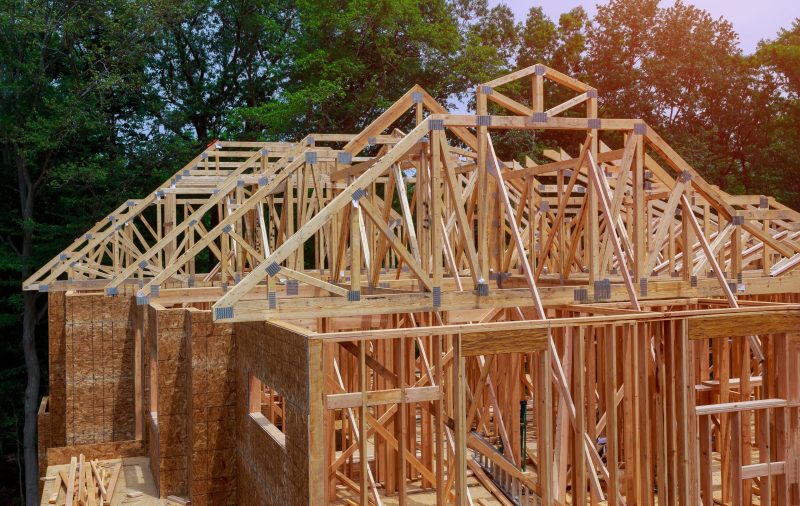
Construction loans are a type of financing that helps you build or renovate a property. They differ from traditional mortgages because they are designed to cover the costs of construction rather than the purchase of a completed home. Construction loans are widely available, and they can help you turn your dream home into a reality.
New construction loans provide funding for the entire construction process, including land acquisition, building materials, labor costs, and other related expenses. We’ll cover everything you need to know about new construction loans, including how they work, the different types of construction loans, and the eligibility requirements.
How Do Construction Loans Work?
Construction loans work differently from traditional mortgages. With a traditional mortgage, the lender provides the funds to purchase a home. With a construction loan, the lender provides funds to cover the costs of building a home or renovating an existing property.
Construction loans are typically paid out in stages (or draws) rather than as a lump sum. The lender will usually have a set number of draws the builder can take based on the amount of the home construction loan and its complexity. The payments are typically made to the builder or contractor, rather than the borrower directly.
Different Types of Construction Loans
There are several different types of construction loans available. Here are the most common ones:
Construction-Only Loans
These are short-term loans that cover the cost of construction only. Once the construction is complete, the borrower will need to obtain a traditional mortgage to pay off the construction loan.
Construction-to-Permanent Loans
These loans combine the construction loan and the mortgage into one loan. The borrower will typically pay a higher interest rate during the construction phase, but the loan will automatically convert to a traditional mortgage once the construction is complete. These loans are typically used when a borrower has already acquired the land for the home.
One-Time Close Construction Loans
A One-Time Close New Construction loan is a single-closing construction loan. The construction portion is short-term financing that is modified into permanent financing upon completion of the project. A single-closing construction mortgage can be closed as a purchase or a refinance.
Renovation Loans
Renovation loans are designed to cover the costs of renovating an existing property. They can be used for both major and minor renovations.
VA Construction Loans
If you’re a U.S. military veteran dreaming of building your ideal home, the U.S. Department of Veterans Affairs (VA) offers a unique financing option that combines the benefits of a VA home loan with the flexibility of constructing your residence from the ground up.
Eligibility Requirements
To be eligible for a construction loan, you will need to meet certain requirements. Here are some of the most important ones:
Credit Score
Most lenders will require a credit score of at least 620 to qualify for a construction loan.
Down Payment
You will need to make a down payment of the total cost of the project, to be determined by the type of new construction loan (FHA, VA, USDA, Conventional, etc.).
Income Verification
You will need to provide proof of income, such as pay stubs, tax returns, or employment contracts.
Builder Approval
The lender will require the builder or contractor to be approved by the lender’s 3rd party project administrator before they will provide a construction loan. The approval fee will be paid by the borrower.
Project Approval
The project must be approved by the 3rd party project administrator. The project approval process can be started once a property is found and should be completed before the loan entering CTC. The approval fee will be paid by the borrower.
Detailed Plans
You must provide detailed plans and cost estimates for the construction project.
Other requirements
While construction loans offer many benefits, they also come with specific requirements that borrowers must meet. These requirements typically include:
A clear plan for the construction project
Lenders will want to see a detailed plan for the construction project, including timelines, budgets, and building plans. This will help ensure that the project is viable and that the borrower has a clear understanding of the costs and timeline involved.
Adequate income and assets
Borrowers will need to demonstrate that they have the income and assets necessary to repay the loan. This may include providing proof of income, bank statements, and other financial documents.
Benefits of Construction Loans
There are several benefits to using a construction loan to build or renovate a property. Here are a few of the most important ones:
Flexibility
Construction loans are typically more flexible than traditional mortgages. The lender will work with you to create a payment schedule that fits your needs.
Interest-Only Payments
During the construction phase, you will only be required to make interest-only payments, which can help keep your payments low. In the case of VA New Construction loans, no payment will be made until the home is completed.
Lower Interest Rates
Construction loans typically have lower interest rates than traditional mortgages, which can save you money in the long run.
Customizable
When you build a home, you have the ability to customize it to your specific needs and preferences.
Application Process for Construction Loans
The application process for construction loans can be more complex than for traditional mortgage loans. Borrowers will typically need to provide a lot of documentation and work closely with the lender throughout the process. The following is an overview of the steps involved in the application process:
Pre-qualification
Before applying for a construction loan, borrowers get pre-qualified with a lender. This will help them determine how much they can borrow and what their interest rate and repayment terms might be.
Submit an application
Once pre-qualified, borrowers can submit a formal application for the loan. This will typically include providing financial documents, building plans, and other supporting materials.
Builder/Contractor approval
The builder/contractor must be approved to be eligible to complete the project. The approval process can be started before a property is found and must be completed on every loan regardless of if the builder/contractor is already approved.
The builder/contractor approval process must be completed prior to underwriting.
Loan underwriting
After the application is submitted, the lender will review the borrower’s financial and building plans to determine if they meet the lender’s criteria for the loan. This may involve a property appraisal, a credit check, and other due diligence.
Loan approval
If the borrower meets the lender’s criteria, the loan will be approved, and the terms of the loan will be finalized. This may include determining the interest rate, repayment terms, and other conditions or requirements.
Construction phase
Once the loan is approved, the borrower can begin the project’s construction phase. During this time, the lender will typically disburse funds as needed to cover the cost of the project.
Conclusion
Construction loans can provide a valuable source of financing for those looking to build their dream homes. While the process of obtaining a construction loan can feel complex, our New Construction Loan experts at Six Pillar Lending will guide you (and your builder) through the process and make it as seamless as possible.
Have questions? Give us a call! One of our mortgage specialists would be happy to answer all of your questions.
**Six Pillar Lending LLC is not affiliated with or acting on behalf of or at the direction of FHA, VA, USDA, or the Federal Government.

